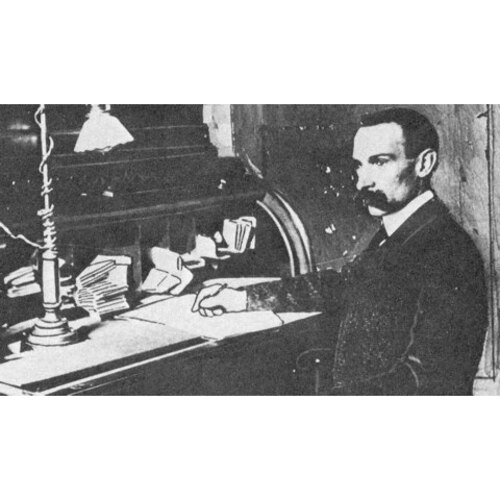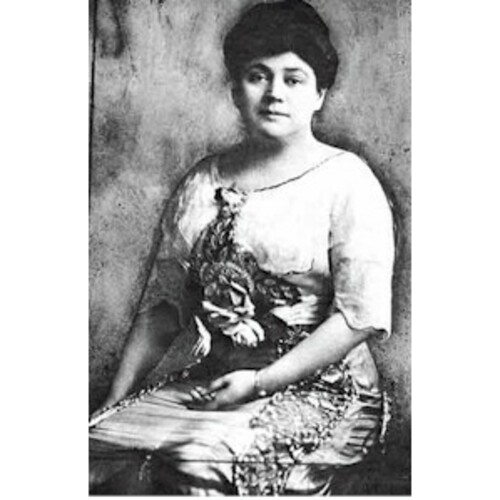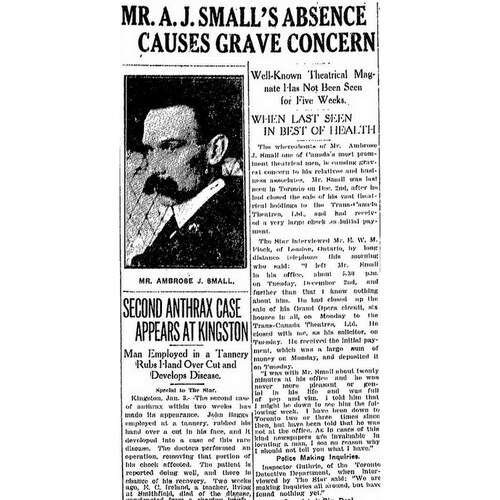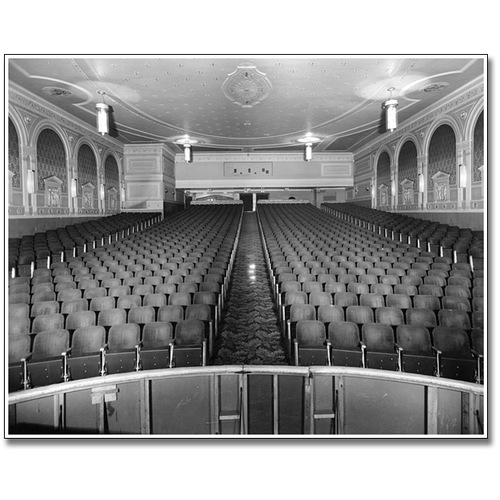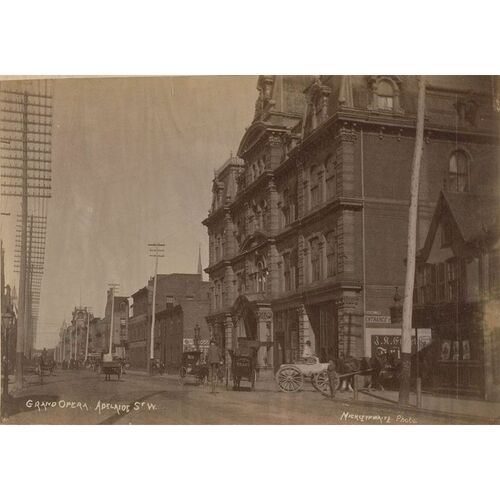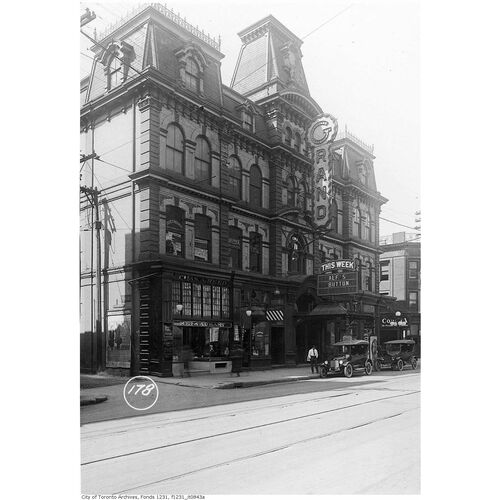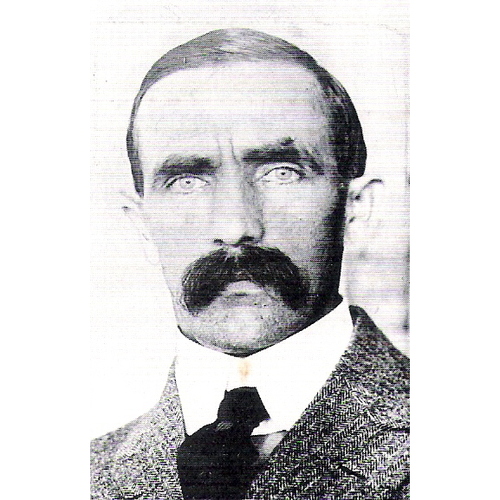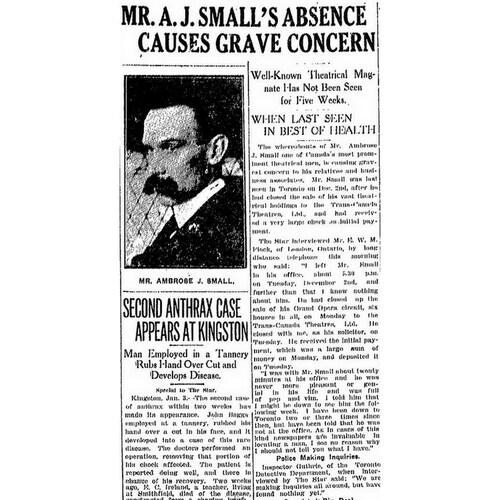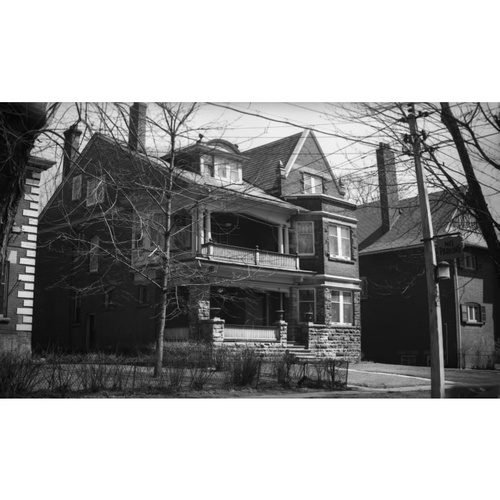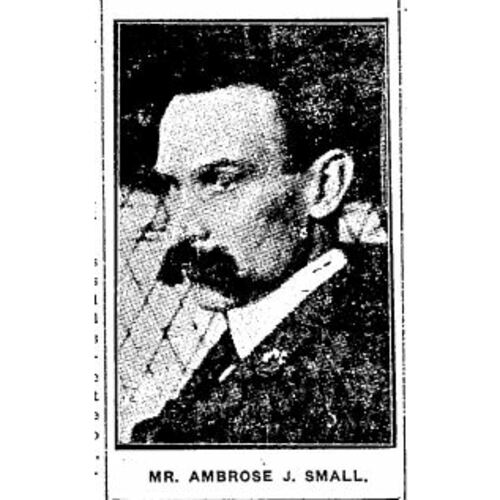![Mr. Ambrose J. Small. Source: Toronto Daily Star [Toronto, Ontario]. 03 Jan 1920: page 1. Original title: Mr. Ambrose J. Small. Source: Toronto Daily Star [Toronto, Ontario]. 03 Jan 1920: page 1.](/bioimages/w600.14299.jpg)
Source: Link
SMALL, AMBROSE JOSEPH, impresario; b. 11 Jan. 1866 in Bradford, Upper Canada, son of Daniel Small and Ellen Brazil (Brazille, Brazell); m. 6 Nov. 1902 Theresa Kormann in Toronto; they had no children; disappeared there 2 Dec. 1919.
About 1875 Ambrose Small’s father, a son of Irish Catholic immigrant settlers, moved his family to Toronto, where he ran a hotel-saloon. Ambrose may have attended St Michael’s College and De La Salle Institute, both in Toronto. By some accounts his father instilled in him a tremendously strong work ethic. In 1880 Daniel Small became proprietor of the Grand Hotel, in which brewer Ignatius Kormann had an interest; situated on Adelaide Street West, it was adjacent to Alexander Henderson Manning*’s Grand Opera House, on the New York-based circuit of Augustus Pitou. In 1891, three years after Ellen’s death, Daniel married Kormann’s daughter Josephine.
Ambrose Small’s rise was meteoric. By 1884 he was busily engaged at the Grand Opera House, ushering, running its bar and an informal matchmaking bureau, and taking bets on racehorses. In 1889, then its treasurer, he quarrelled with manager Oliver Barton Sheppard and moved to the nearby Toronto Opera House, a vaudeville and melodrama theatre on the circuit of Henry R. Jacobs of New York and his Montreal partner John Bolingbroke Sparrow. Small worked his way up to manager, learning as he advanced all about international syndicates, bookings, and public tastes in entertainment. Although known as a reckless gambler at racetracks, by 1892 he held mortgages on two Toronto theatres (his own and the Regent Theatre) and was beginning to build wider alliances.
Adaptive to change, Small pushed himself to the front of theatrical management in Ontario. Under his management actor Robert C. Cummings formed a stock company in 1897, the first in Toronto since the 1870s. In the peak years around 1900, when more than 300 companies were on tour, Small booked astutely and capitalized on English and American stars wishing to work in Canada; as the number of touring shows declined, he ran vaudeville and later presented moving pictures. Following the death in 1902 of Clark J. Whitney of Detroit, who had controlled a major circuit in Ontario, some of it in partnership with Small, he consolidated his holdings by buying theatres in such centres as Hamilton, Kingston, Toronto, St Thomas, and Peterborough. In the process Small, who in 1906 was elected president of the Canadian Theatrical Managers’ Association, wrested booking control from the New York syndicates, developed a circuit of 34 theatres (half of them outside Ontario) through ownership, lease, or control of booking, and amassed a fortune. In 1912 his circuit was justly described by Michael Bennett Leavitt as “one of the most carefully booked . . . in America.”
Endowed with a magnetic personality and great energy, Small attracted women, especially chorus girls, whom he rewarded with chocolates if he liked them. He courted his stepmother’s younger sister Theresa, marrying her in 1902 just as her mother’s estate was being probated. In every sphere except their desire for wealth – they eventually took up residence in Rosedale – they were opposites. A linguist, artist, and musician, the “buxom” Theresa was charitable and pious; Ambrose was seen as “brazenly unscrupulous.” As business partners they acted as one. Theresa’s inheritance helped her husband purchase the Grand in 1903 – something he had vowed to do – and three years later he ousted Sheppard, who then concentrated on developing the Princess Theatre on King Street as a better class of theatre, leaving the “tawdry” field of musicals and melodramas to Small. Once he owned the Grand, Small, while Theresa was travelling in Europe, had a secret chamber, complete with a bar, a painting of a nude woman, and an opulent bed, constructed there so he could consort with women. His wife was aware of his extramarital interests, to the extent that she did not report his disappearance in December 1919 because she feared a scandal: “I believe my Amby is in the hands of a designing woman, somewhere, and will come back.”
Faced with increasing production costs and decline in the theatrical touring business, in late November 1919 the Smalls had sold their chain for $1.7 million to Trans-Canada Theatres Limited; on 1 December they received $1 million on account. The following morning, while Theresa was depositing the cheque, Ambrose was ordering a Cadillac, a fur coat, and jewellery for her. He met with his lawyer at the Grand in the afternoon; later that day Ambrose Small disappeared without a trace. In January, after a preliminary police investigation, Theresa posted rewards and an international hunt ensued; notices described Small as “very quick in his movements,” 5 feet 9 inches in height, 150–60 pounds in weight, with blue eyes, brown hair, and a moustache streaked with grey. A former employee was convicted of stealing bonds from Small’s bank box on 2 December, but charges of kidnapping were never pressed against anyone and Small’s body was never found.
Because Theresa vowed to leave their fortune to the Catholic Church, a vicious tabloid war flared up. Small’s sisters, Mary Florence Maude and Gertrude Mercedes, hired private detective Patrick Sullivan to find his body, and restore his sullied reputation. In a sketch prepared by Sullivan to counter “unscrupulous lying traducers,” Small was portrayed as a “brainy,” hard-working businessman who, shunning debauchery, had “never showed the smallest tendency to deviate from the path of righteousness.” In 1923 Small was pronounced dead for purposes of probate. His 1903 will, which left everything to his wife, was contested by his sisters without success, and Theresa, who had become a recluse after he had vanished, was granted the estate, valued at $1,087,831.70. (Only after her death in 1935 would she leave anything to the church.)
Small’s disappearance continued to capture the public imagination. One theory revolved around his wife having a lover in London, Ont. At the Grand Opera House there, a Small holding, a caretaker who had smelled fumes from its furnace claimed that Theresa and her lover had murdered and incinerated Small. Whether the story is true or not, he lingers in legend as the theatre’s ghost. In 1928 journalist Hector Willoughby Charlesworth* definitely believed murder had ended the career of one he had known well for more than 25 years and whose mean-spirited methods he disdained, though he acknowledged Small’s managerial importance. Other would-be detectives have agreed with this conclusion of foul play. Since the 1920s, a number of books and articles, paintings, and a radio play have probed Small’s personality and disappearance. Michael Ondaatje’s In the skin of a lion (Toronto, 1987), which incorporates the search for Small in 1920, captures his contribution to the cultural consciousness by transforming him into “the jackal of Toronto’s business world . . . . He was bare-knuckle capitalism.” In this novel the Small character declares, “I’m a thief . . . . All thieves must plan their escape route.” The last plans of Ambrose Small remain a conundrum.
AO, RG 22-305, nos.15671, 50038; RG 80-5-0-192, no.14444; RG 80-5-0-298, no.2971; RG 80-27-2, 66: 206. MTRL, PA, Vert. file, theatre companies, Ambrose Small (former Theatre Dept. clipping files, preserved on microfiche), esp. Patrick Sullivan, “The Ambrose Small mystery: startling revelations by Patrick Sullivan” (clipping from an unidentified Toronto publication, 9 Sept. 1922); SC, Theatre manuscripts, Thomas Scott coll. NA, RG 31, C1, Toronto, 1881, St Andrew’s Ward, subdiv.1: 19; 1891, St Thomas’ ward, subdist.1: 19; 1901, Ward 2, div.12: 22. Univ. of Western Ont. Library, Regional Coll. (London), E. M. W. Flock coll. R. T. Allen, “What really happened to Ambrose Small?” Maclean ‘s (Toronto), 64 (1951), no.2: 12–13, 35–36. Mary Brown, “Ambrose Small: a ghost in spite of himself,” in Theatrical touring and founding in North America, ed. L. W. Conolly (Westport, Conn., and London, 1982), 77–88. Canadian men and women of the time (Morgan; 1912). H. [W.] Charlesworth, More candid chronicles: further leaves from the note book of a Canadian journalist (Toronto, 1928). Directory, Toronto, 1875–1919. Early stages: theatre in Ontario, 1800–1914, ed. Ann Saddlemyer (Toronto, 1990). W. A. Hewitt, “Toronto’s greatest racetrack plunger,” Thoroughbred of Canada (Toronto), February 1954: 16–18. M. B. Leavitt, Fifty years in the theatrical management (New York, 1912). Fred McClement, The strange case of Ambrose Small (Toronto, 1974). W. S. Wallace, Murders and mysteries: a Canadian series (Toronto, 1931; repr. Westport, 1975); “The Small mystery,” Maclean’s, 44 (1931), no.14: 6, 50–51.
Cite This Article
Kathleen D. J. Fraser, “SMALL, AMBROSE JOSEPH,” in Dictionary of Canadian Biography, vol. 14, University of Toronto/Université Laval, 2003–, accessed December 4, 2025, https://www.biographi.ca/en/bio/small_ambrose_joseph_14E.html.
The citation above shows the format for footnotes and endnotes according to the Chicago manual of style (16th edition). Information to be used in other citation formats:
| Permalink: | https://www.biographi.ca/en/bio/small_ambrose_joseph_14E.html |
| Author of Article: | Kathleen D. J. Fraser |
| Title of Article: | SMALL, AMBROSE JOSEPH |
| Publication Name: | Dictionary of Canadian Biography, vol. 14 |
| Publisher: | University of Toronto/Université Laval |
| Year of publication: | 1998 |
| Year of revision: | 1998 |
| Access Date: | December 4, 2025 |


